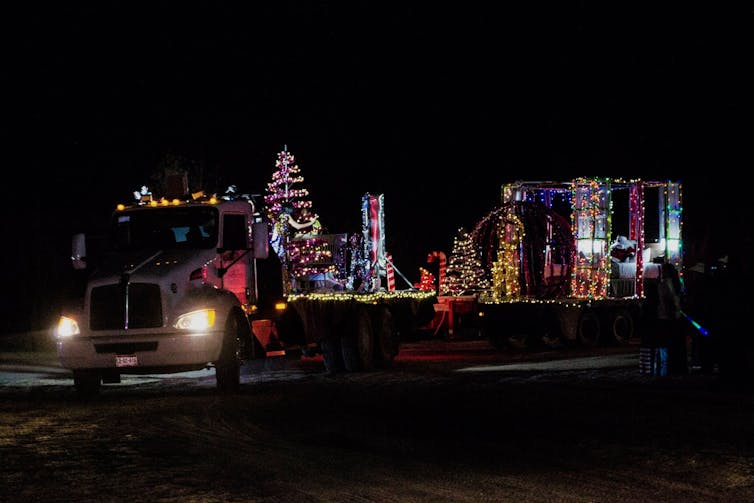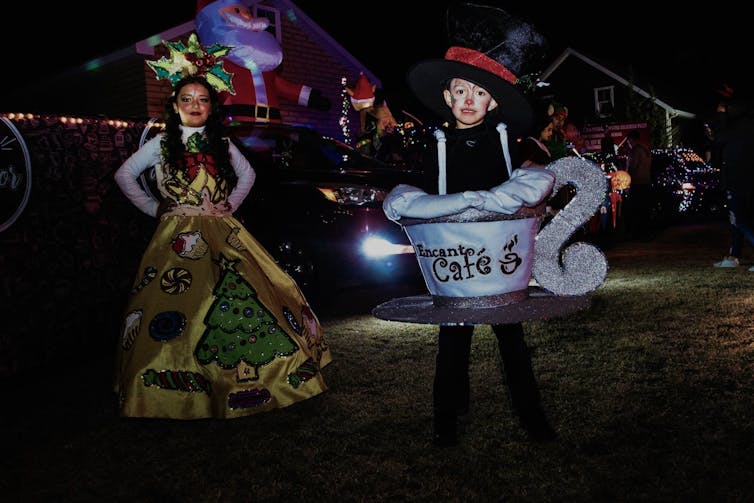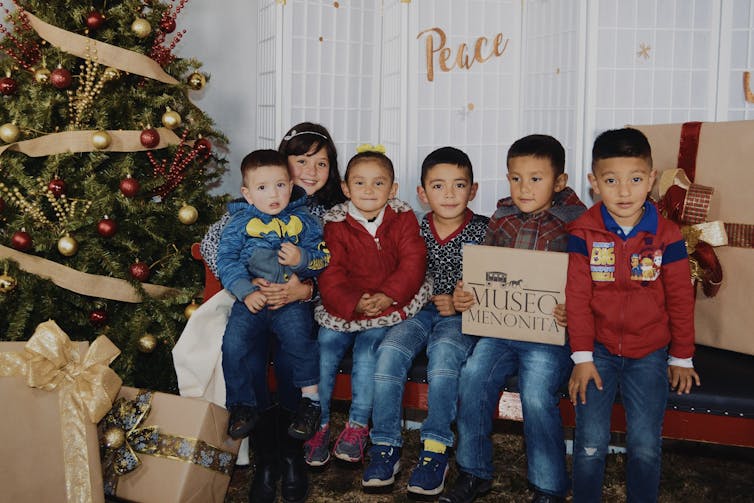Mexican Mennonites combat fears of violence with a new Christmas tradition
- Written by Rebecca Janzen, Assistant Professor of Spanish and Comparative Literature, University of South Carolina
Mennonites in Mexico are promoting a bright new Christmas tradition – one born of somber origins.
The “Parade of Lights,” a nighttime procession of decorated vehicles and holiday party held this year on Dec. 7, was created by the Mennonite Museum[1] in the northern Mexican state of Chihuahua to give local people – both Mennonite and Mexican alike – a safe, family-friendly way to celebrate Christmas amid growing violence.
Drug cartels often battle for control over Chihuahua[2], which lies along the U.S. border. In 2010[3], the deadliest year on record, the state had 6,421 murders. Crime then dropped for several years but is now rising sharply[4]. Between 2014 and 2018, murders in Chihuahua increased 70%, from 1,758 in 2014[5] to nearly 3,000 in 2018[6].
Living in rather closed Christian communities, as Mennonites have for a century in Mexico, cannot entirely protect them from chronic and sometimes random violence. In 2012, the wife[7] of a Mennonite pastor in Chihuahua was killed while traveling to a funeral. In 2017, three local men were shot in the Mennonite colony[8] where they lived.
The Parade of Lights was created in 2017 in hopes of nurturing Chihuahua’s holiday spirit despite perceptions of danger.
A new Christmas tradition
This year, organizers say, about 4,000 people gathered on Dec. 7 to watch the main event: a parade of cars and trucks decorated with snowmen, presents, reindeer and nativity scenes. The procession starts in the Chihuahuan city of Cuauhtémoc, drives slowly down a normally busy highway, and ends at the Mennonite Museum eight miles away.
Antonio Loewen[9], the Mennonite Museum’s former director, created the holiday parade in 2017 as a way to “lift up [local] villages” – that is, counteract negative views that the area is cartel-ridden and dangerous[10].
 A truck decorated for the 2019 Parade of Lights, near Ciudad Cuauhtémoc, Chihuahua, Mexico, Dec. 7, 2019.
Courtesy of: Museo y Centro Comercial Menonita, Author provided[11]
A truck decorated for the 2019 Parade of Lights, near Ciudad Cuauhtémoc, Chihuahua, Mexico, Dec. 7, 2019.
Courtesy of: Museo y Centro Comercial Menonita, Author provided[11]
The museum opened in 2001 in the countryside outside Cuauhtémoc, Chihuahua – home to the largest grouping of Mennonite villages in Mexico – to teach people in Mexico about the Mennonite religion and culture. Cuauhtémoc is sometimes called the “City of Three Cultures[12]” because of its Mennonite, northern Mexican and indigenous Mexican populations.
There are roughly 100,000 Mennonites[13] in Mexico, descendants of Canadians who emigrated to Mexico almost a century ago, after World War I.
Members of this religious minority, which arose in northern Europe during the 16th century[14], hold beliefs similar to those of other Protestant Christians. But their lifestyle is intentionally different. Mennonites are pacifists[15] who refuse military service. They tend to live apart from the outside world, practice adult baptism and are skeptical of technology’s encroachment on society[16].
While conducting research for my 2018 book on religious minorities in Mexico[17], I interviewed many Mennonites from Chihuahua about their beliefs and traditions. My father – a Canadian Mennonite with family in Mexico who has studied the migration of this community[18] – served as my interpreter.
Mexican Mennonites have maintained their culture by living in rather isolated villages called colonies. Most still speak a Dutch-like language called Low German[19] and maintain the traditional dress of head coverings and long dresses for women and overalls for men.
Some Mennonites in northern Mexico still travel by horse and buggy and limit their use of electricity[20]. Others wear modern dress and attend Protestant churches in Spanish with their neighbors[21].
Cultural engagement
The Mennonite Museum and Cultural Center, which is funded by the Chihuahua state government[22], sees the Parade of Lights as part of its mission of outreach to the broader Mexican community.
 Children dressed up for the 2019 Parade of Lights in Chihuahua state, Mexico, Dec. 7, 2019.
Courtesy of: Museo y Centro Cultural Menonita, Author provided[23]
Children dressed up for the 2019 Parade of Lights in Chihuahua state, Mexico, Dec. 7, 2019.
Courtesy of: Museo y Centro Cultural Menonita, Author provided[23]
The first year the event was held, in 2017, 3,000 people attended – vastly exceeding the 400 guests the museum expected[24], according to Loewen. A few local businesses and churches decorated cars to drive in the parade.
Word has spread since then.
This year, dozens of local families, churches and companies – including Quesería Dos Lagunas, one of the companies that makes the cheese Mennonites are famous for in Mexico – created floats with nativity scenes[25] and decked out their vehicles for the parade. Afterwards, Mennonites and families from Cuauhtémoc gathered at the museum for popcorn and tamales – a traditional Christmas food in Mexico[26] – joined by the mayor of Cuauhtémoc[27].
 A holiday portrait after Chihuahua’s Parade of Lights, Dec. 7, 2019.
Courtesy of the Museo y Centro Cultural Menonita, Author provided[28]
A holiday portrait after Chihuahua’s Parade of Lights, Dec. 7, 2019.
Courtesy of the Museo y Centro Cultural Menonita, Author provided[28]
Helmut Reimer, general manager of the Microtel Inn & Suites, a local hotel that helped organize the festivities, told me he hoped the parade would “reverse” the image people have of “insecurity and ugly things” in Chihuahua.
Last year Chihuahua state had three times the number of murder as neighboring Sonora state, which has a similar population[29].
The Christmas parade is the latest of several local Mennonite projects[30] in Chihuahua aimed at bringing together the peoples of northern Mexico to grapple with pervasive crime that disproportionately affects them all.
Because they traverse religious and ethnic borders, such efforts represent more than just a reaction to violence. They confirm that while Mennonites may dress, talk or pray differently than their neighbors, they are part of Chihuahua’s local community, too.
[Deep knowledge, daily. Sign up for The Conversation’s newsletter[31].]
References
- ^ Mennonite Museum (www.facebook.com)
- ^ battle for control over Chihuahua (www.washingtonpost.com)
- ^ 2010 (www.inegi.org.mx)
- ^ rising sharply (theconversation.com)
- ^ 1,758 in 2014 (www.inegi.org.mx)
- ^ nearly 3,000 in 2018 (www.jornada.com.mx)
- ^ wife (mwc-cmm.org)
- ^ were shot in the Mennonite colony (www.elpasotimes.com)
- ^ Antonio Loewen (www.youtube.com)
- ^ that the area is cartel-ridden and dangerous (abigailcarlklassen.wordpress.com)
- ^ Courtesy of: Museo y Centro Comercial Menonita (www.facebook.com)
- ^ City of Three Cultures (www.youtube.com)
- ^ 100,000 Mennonites (www.sunypress.edu)
- ^ northern Europe during the 16th century (www.lmhs.org)
- ^ pacifists (anabaptistwiki.org)
- ^ technology’s encroachment on society (utorontopress.com)
- ^ 2018 book on religious minorities in Mexico (www.sunypress.edu)
- ^ migration of this community (openingdoors.co)
- ^ Low German (mennoniteeducation.weebly.com)
- ^ electricity (utorontopress.com)
- ^ Protestant churches in Spanish with their neighbors (mwc-cmm.org)
- ^ Chihuahua state government (sic.cultura.gob.mx)
- ^ Courtesy of: Museo y Centro Cultural Menonita (www.facebook.com)
- ^ expected (www.youtube.com)
- ^ floats with nativity scenes (www.facebook.com)
- ^ a traditional Christmas food in Mexico (themazatlanpost.com)
- ^ the mayor of Cuauhtémoc (vivirenjuarez.com.mx)
- ^ Courtesy of the Museo y Centro Cultural Menonita (www.facebook.com)
- ^ a similar population (www.inegi.org.mx)
- ^ local Mennonite projects (www.youtube.com)
- ^ Sign up for The Conversation’s newsletter (theconversation.com)
Authors: Rebecca Janzen, Assistant Professor of Spanish and Comparative Literature, University of South Carolina


